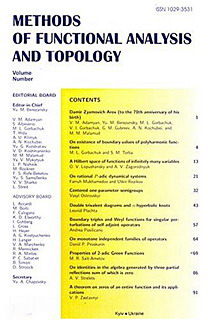Vol. 16 (2010), no. 4
Israel Gohberg
MFAT 16 (2010), no. 4, 289-290
289-290
In Memoriam Israel Gohberg
MFAT 16 (2010), no. 4, 291-297
291-297
Singularly perturbed normal operators
MFAT 16 (2010), no. 4, 298-303
298-303
We give an effective description of finite rank singular perturbations of a normal operator by using the concepts we introduce of an admissible subspace and corresponding admissible operators. We give a description of rank one singular perturbations in terms of a scale of Hilbert spaces, which is constructed from the unperturbed operator.
Harmonic analysis on a locally compact hypergroup
A. A. Kalyuzhnyi, G. B. Podkolzin, Yu. A. Chapovsky
MFAT 16 (2010), no. 4, 304-332
304-332
We propose a new axiomatics for a locally compact hypergroup. On the one hand, the new object generalizes a DJS-hypergroup and, on the other hand, it allows to obtain results similar to those for a unimodular hypecomplex system with continuous basis. We construct a harmonic analysis and, for a commutative locally compact hypergroup, give an analogue of the Pontryagin duality theorem.
On $J$-self-adjoint extensions of the Phillips symmetric operator
S. Kuzhel, O. Shapovalova, L. Vavrykovych
MFAT 16 (2010), no. 4, 333-348
333-348
$J$-self-adjoint extensions of the Phillips symmetric operator $S$ are %\break studied. The concepts of stable and unstable $C$-symmetry are introduced in the extension theory framework. The main results are the following: if ${A}$ is a $J$-self-adjoint extension of $S$, then either $\sigma({A})=\mathbb{R}$ or $\sigma({A})=\mathbb{C}$; if ${A}$ has a real spectrum, then ${A}$ has a stable $C$-symmetry and ${A}$ is similar to a self-adjoint operator; there are no $J$-self-adjoint extensions of the Phillips operator with unstable $C$-symmetry.
Spectral problem for figure-of-eight graph of Stieltjes strings
MFAT 16 (2010), no. 4, 349-358
349-358
We describe the spectrum of the problem generated by the Stieltjes string recurrence relations on a figure-of-eight graph. The continuity and the force balance conditions are imposed at the vertex of the graph. It is shown that the eigenvalues of such (main) problem are interlaced with the elements of the union of sets of eigenvalues of the Dirichlet problems generated by the parts of the string which correspond to the loops of the figure-of-eight graph. Also the eigenvalues of the main problem are interlaced with the elements of the union of sets of eigenvalues of the periodic problems generated by the same parts of the string.
Direct and inverse problems for generalized Pick matrix
MFAT 16 (2010), no. 4, 359-382
359-382
All matrix modifications of classical Nevanlinna-Pick interpolation problem with a finite number of nonreal nodes which can be investigated by V. P. Potapov method are described.
On the number of negative eigenvalues of a multi-dimensional Schrodinger operator with point interactions
MFAT 16 (2010), no. 4, 383-392
383-392
We prove that the number $N$ of negative eigenvalues of a Schr\"odinger operator $L$ with finitely many points of $\delta$-interactions on $\mathbb R^{d}$ (${d}\le3$) is equal to the number of negative eigenvalues of a certain class of matrix $M$ up to a constant. This $M$ is expressed in terms of distances between the interaction points and the intensities. As applications, we obtain sufficient and necessary conditions for $L$ to satisfy $N=m,n,n$ for ${d}=1,2,3$, respectively, and some estimates of the minimum and maximum of $N$ for fixed intensities. Here, we denote by $n$ and $m$ the numbers of interaction points and negative intensities, respectively.


